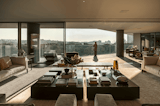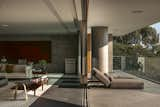66 more photos
Credits
From Armentano Arquitetura
Overlooking Parque do Povo in the Itaim Bibi neighborhood of São Paulo, the building designed by Aflalo/Gasperini has its west façade fully composed of balconies and a geometry that follows the layout of the park, enhancing the apartments’ views of the greenery.
The volumetry defined by the architectural project generates a floor plan organized into two programmatic blocks: the living area, set at an angle in relation to the surrounding streets, and the private area with a Cartesian spatial configuration. In the latter, the P570 adopts a color palette dominated by shades of gray. Even with the use of wood finishes that warm the bedrooms, the tones remain muted to create calm environments in which the view of the park and the sunset become the main sources of chromatic saturation. This logic is repeated in the spatial composition of the private bathrooms, both in the porcelain tiles covering the floors and walls of the suites and in the marble veins that line the master bathroom entirely.
In the living spaces, the project takes on another layer of complexity. Taking advantage of the building’s independent structure, the team chose to integrate the entire social area of the apartment. This spatial continuity not only enlarges the area but also enhances the role of the privileged view in shaping the interior experience, eliminating visual obstacles between the glass-enclosed interior, the balcony, and the treetops of Parque do Povo. This solution is
also extended to the interface between the living room and the apartment’s service core, where the dining room is separated from the breakfast area and the kitchen only by a large glass prism - the wine cellar -which defines the space without fragmenting it. Cementitious slabs cover the entire living area and extend into the kitchen and service spaces, reinforcing the integration between these areas. Their dark tone is similar to that used in the kitchen cabinetry and marble countertops, a homogeneity contrasted by the luminous surface of the sphere in Illuminator by Zilvinas Kempinas.
With an open and integrated floor plan, the interior design of the apartment’s social area proposes a more varied composition, balancing on one hand the chromatic uniformity established by the flooring material, concrete pillars, and walls, and on the other, the dynamism of the panoramic view. This mediation is achieved by expanding the palette of materials, colors, and forms and by creating living clusters that suggest different uses for the space. The warm tone of the wood paneling dialogues with the jacaranda wood of the Mucki
bench and the leather of the Beg armchairs by Sérgio Rodrigues; the expressive focus of a photograph by Cláudio Edinger energizes the abstraction of a work by Tomie Ohtake. It is in the relationships between materials and scales, images and objects, that the composition of P570 gains its strength and moves from a set of design solutions to a space that conveys the identity of its residents.




















